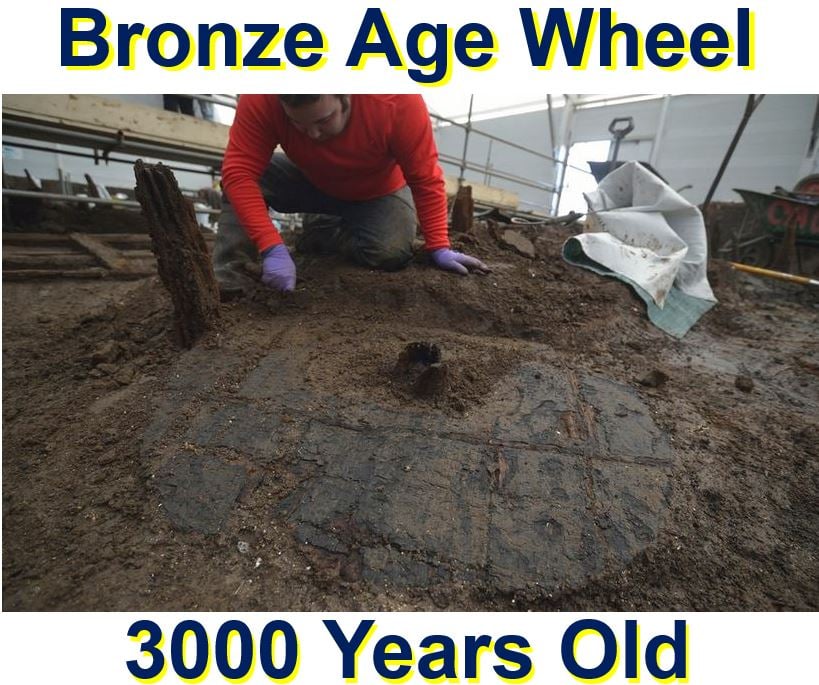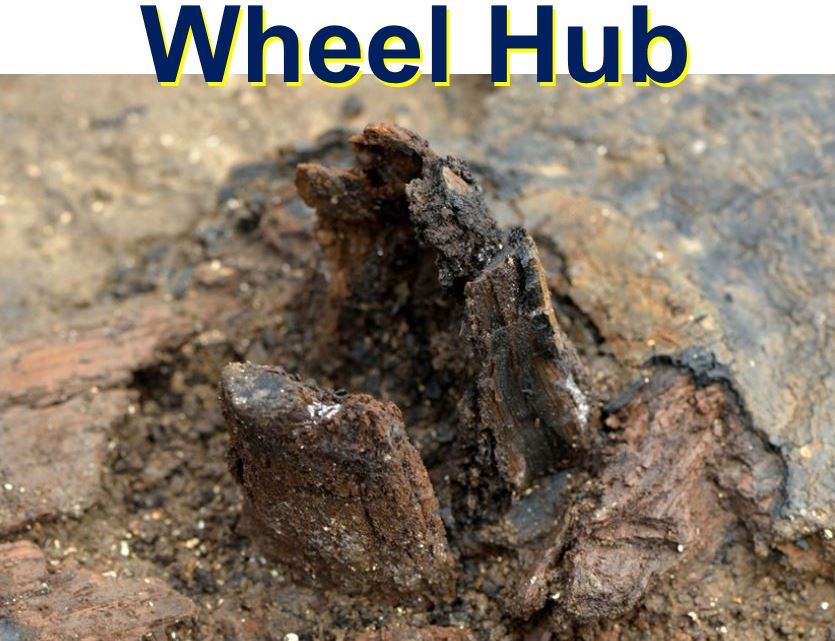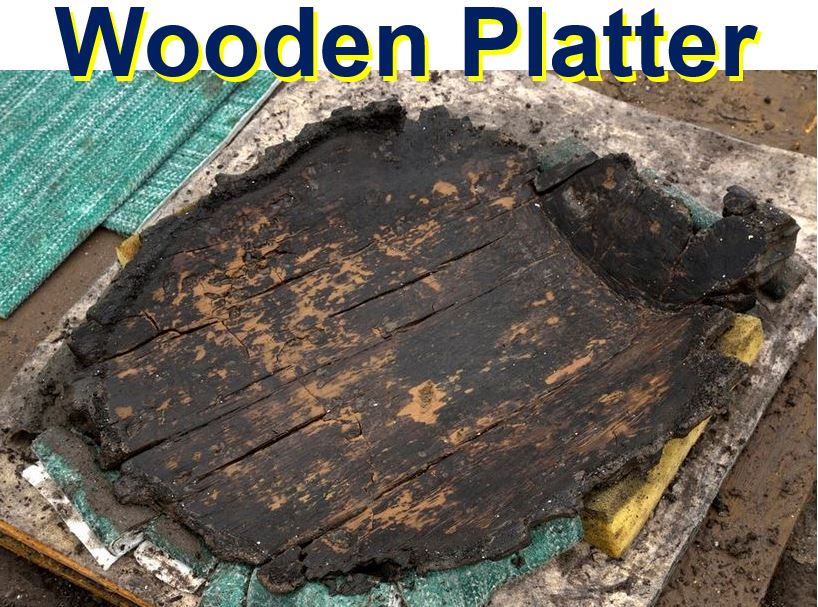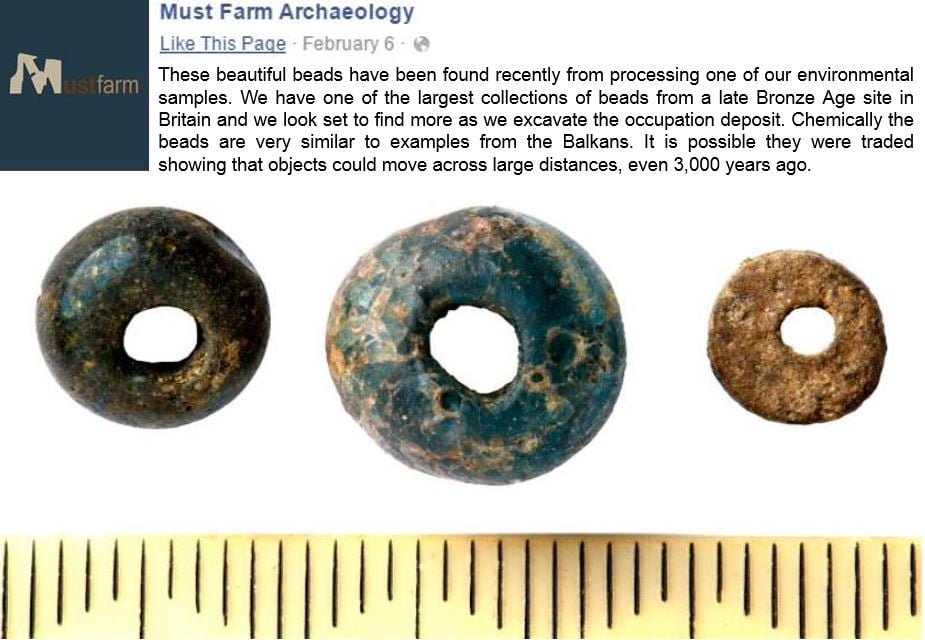A 3000 year old wheel has been found at the Must Farm archaeological site, known as British Pompeii, making it the most complete and well preserved Bronze Age wheel ever to be discovered in the country. At Must Farm, several houses and artefacts dating to the Bronze Age have been unearthed this year.
Experts believe the wheel, which is one metre across, dates from 1100 to 800 BC. It is so well preserved that it still has its hub.
Members of the Cambridge Archaeological Team, part of the University of Cambridge, who are leading the investigation at Must Farm Quarry near Wittlesey, an ancient Fenland market town six miles (10 km) from Peterborough in East Anglia, say this is an unprecedented find in terms of completeness and size.
 The archaeologists were amazed to find the 3000 year old Bronze Age wheel in such good condition. Its hub is clearly visible. (Image: historicengland.org.uk. Credit: Cambridge Archaeological Unit)
The archaeologists were amazed to find the 3000 year old Bronze Age wheel in such good condition. Its hub is clearly visible. (Image: historicengland.org.uk. Credit: Cambridge Archaeological Unit)
Wheel found close to Bronze Age houses
The wheel was found near to the UK’s best-preserved Bronze Age dwellings, which caught fire and fell into the riverbed, where they were preserved in clay and silt.
The discovery poses challenges to anthropologists’, historians’ and archaeologists’ understanding of what Late Bronze Age technology was like in Britain three thousand years ago.
Chief Executive of Historic England, Duncan Wilson said:
“This remarkable but fragile wooden wheel is the earliest complete example ever found in Britain. The existence of this wheel expands our understanding of Late Bronze Age technology and the level of sophistication of the lives of people living on the edge of the Fens 3,000 years ago.”
Several spectacular finds at Must Farm site
This latest find is but one of several discoveries at Must Farm which are providing an extraordinary insight into what domestic life was like for early Britons three thousand years ago.
Other spectacular finds include a wooden platter, a small wooden box with its contents still inside, an intact box, three circular wooden houses that were once propped up on stilts, rare small jars and bowls with food remains still inside, as well as textiles made from lime tree bark fibres.
 Close up of the wooden hub of the wheel. (Image: historicengland.org.uk. Credit: Cambridge Archaeological Unit).
Close up of the wooden hub of the wheel. (Image: historicengland.org.uk. Credit: Cambridge Archaeological Unit).
Although this settlement was near rivers with lots of fish, according to the contents of the unearthed bowls, the Bronze Age Britons of East Anglia preferred beef and mutton.
People in Britain were much more sophisticated three thousand years ago than previously thought. Several glass beads that formed part of an elaborate ornamental necklace have also been found.
Archaeological Manager at the Cambridge Archaeological Unit, David Gibson, said:
“The discovery of the wheel demonstrates the inhabitants of this watery landscapes links to the dryland beyond the river.”
People fled their burning homes in a hurry
Charred roof timbers are clearly visible in one of the roadhouses. The whole site was surrounded by a palisade (wooden posts).
According to the archaeologists, the inhabitants ran out of their burning homes leaving all their possessions behind. This was unfortunate for them but fortunate for us, because everything has been remarkably well preserved in riverbed silt. The archaeological team says it even discovered some footprints.
Forensic archaeologists are currently trying to determine what caused the fire that sent the houses crashing down to the riverbed.
In this case, forensic refers to the application of scientific techniques to try to determine why something happened. We commonly use the term when solving crimes.
Brian Chapman, Head of Land and Mineral Resources at Forterra, the company that owns the site, said:
“This is an incredible project which we are delighted to be part of. We understand that the discovery of the wheel is of national importance.”
“We are committed to helping uncover the remaining secrets of this unique site at Must Farm and look forward to working with our partners over the coming months.”
 This wooden platter was found recently. Archaeologists said it is well preserved. (Image: historicengland.org.uk. Credit: Cambridge Archaeological Unit).
This wooden platter was found recently. Archaeologists said it is well preserved. (Image: historicengland.org.uk. Credit: Cambridge Archaeological Unit).
Much more to be found
Archaeologists, who describe the site as ‘a dream come true’, say there is still much more to be found.
After the dig is completed, which is still expected to take a few more months, everything will be taken for further examination and conservation. The artefacts will all be displayed at the Peterborough Museum, as well as other centres across East Anglia.
Ground level at the ancient site was six feet below today’s ground level. The team says it reached the riverbed, as it was when residents lived there three thousand years ago, about one month ago.
Over the last few years, several Bronze Age items have been discovered at the Must Farm Site. Nine log boats in pristine condition were found in 2011, and a rapier and sword in 1969.
 This mostly complete, small, delicate wooden box was found recently. It appears to still have contents preserved inside, which the team has taken great care to leave in place. (Image: historicengland.org.uk. Credit: Cambridge Archaeological Unit).
This mostly complete, small, delicate wooden box was found recently. It appears to still have contents preserved inside, which the team has taken great care to leave in place. (Image: historicengland.org.uk. Credit: Cambridge Archaeological Unit).
Kasia Gdaniec, Senior Archaeologist for Cambridgeshire County Council, said:
“Among the wealth of other fabulous artefacts and the new structural remains of round houses built over this river channel, this site continues to amaze and astonish us with its insight into prehistoric life, the latest being the discovery of this wooden wheel.”
“Believed to be the most complete example yet found from this period, this wheel poses a challenge to our understanding of both Late Bronze Age technological skill and, together with the eight boats recovered from the same river in 2011, transportation.”
 (Image: facebook.com/MustFarmArchaeology)
(Image: facebook.com/MustFarmArchaeology)
Historic England (formerly English Heritage) and building products company Forterra are funding the £1.1 million project to excavate 1,100 square metres of the Must Farm quarry site.
The oldest Bronze Age wheel ever found in the UK is the Flag Fen wheel, which dates to about 1300 BC – however, that one is smaller (0.8m diameter) and is incomplete. The oldest wheels in Europe date to at least 2500 BC, in the Copper Age.
Video – Bronze Age wheel found at Must Farm site
This wheel, probably part of a cart, shows that Bronze Age Britons were probably exploiting the dry land, most likely for hunting and farming. Although they lived in houses on stilts over marshland, the wheel tells us there was also a strong link to the land.

